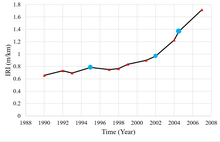مؤشر الخشونة الدولية

مؤشر الخشونة الدولية (بالإنجليزية: International Roughness Index) أو أي أر أي (بالإنجليزية: IRI) هو مؤشر الخشونة الأكثر شيوعًا، يتم الحصول عليه من قياس المقاطع الطولية للطرق. يتم حسابه باستخدام نموذج رياضي لربع مركبة، حيث يتم تجميع استجابته للحصول على مؤشر خشونة مع وحدات منحدر (في in/mile و m/km).[1] يحتوي مقياس الأداء هذا على قدر أقل من العشوائية وعدم الموضوعية بالمقارنة مع مؤشرات أداء الرصيف الأخرى، لكنه لا يخلو تمامًا من العشوائية. تكمن مصادر التباين في بيانات IRI في الفرق بين قراءات التشغيلات المختلفة لمركبة الاختبار والفرق بين قراءات مسارات العجلات اليمنى واليسرى.[1] على الرغم من هذه الحقائق، منذ تقديمه في عام 1986،[2][3][4] أصبح IRI مؤشر خشونة الطريق الأكثر استخدامًا في جميع أنحاء العالم لتقييم وإدارة أنظمة الطرق.[5]
قياس IRI مطلوب للبيانات المقدمة إلى الإدارة الفيدرالية للطرق السريعة بالولايات المتحدة، وهو مُعرف في عدة معايير الجمعية الأمريكية لاختبار المواد:
- "ASTM E1926 - 08"،[6]
- ASTM E1364 - 95 (2005)،[7]
- وغيرها.
يستخدم IRI أيضًا لتقييم إنشاء الرصيف الجديد، ولتحديد العقوبات أو مدفوعات المكافآت على أساس النعومة.
مصادر
[عدل]- ^ ا ب Piryonesi, S. M. (2019). The Application of Data Analytics to Asset Management: Deterioration and Climate Change Adaptation in Ontario Roads (Doctoral dissertation) نسخة محفوظة 2 ديسمبر 2019 على موقع واي باك مشين.
- ^ Sayers, M.W., Gillespie, T. D., and Paterson, W.D. (1984). Guidelines for the conduct and calibration of road roughness measurements. University of Michigan, Highway Safety Research Institute. OCLC:173314520. مؤرشف من الأصل في 2019-12-19.
((استشهاد بكتاب)): صيانة الاستشهاد: أسماء متعددة: قائمة المؤلفين (link) - ^ Sayers, M.W., Gillespie, T. D., and Paterson, W.D. Guidelines for the Conduct and Calibration of Road Roughness Measurements, World Bank Technical Paper No. 46, The World Bank, Washington DC, 1986.
- ^ Sayers, M.W., Gillespie, T. D., and Queiroz, C.A.V. The International Road Roughness Experiment: Establishing Correlation and a Calibration Standard for Measurements, World Bank Technical Paper No. 45, The World Bank, Washington DC, 1986.
- ^ Sayers, M.W.; Karamihas, S.M. (1998). "Little Book of Profiling" (PDF). University of Michigan Transportation Research Institute. Retrieved 2010-03-07.
- ^ "ASTM E1926 - 08(2015) Standard Practice for Computing International Roughness Index of Roads from Longitudinal Profile Measurements" [الممارسة القياسية لحساب مؤشر خشونة الدولي للطرق من قياسات المقاطع الطولية]. www.astm.org. مؤرشف من الأصل في 2019-09-04. اطلع عليه بتاريخ 2019-12-19.
- ^ "ASTM E1364 - 95(2017) Standard Test Method for Measuring Road Roughness by Static Level Method" [طريقة الاختبار القياسية لقياس خشونة الطريق بواسطة طريقة مستوى ثابت]. www.astm.org. 2017. مؤرشف من الأصل في 2019-09-04. اطلع عليه بتاريخ 2019-12-19.
شوارع وطرق | ||||||||||||
|---|---|---|---|---|---|---|---|---|---|---|---|---|
| أنواع الطرق |
| |||||||||||
| Road junctions |
| |||||||||||
| أسطح طرق |
| |||||||||||
| مخاطر طريق |
| |||||||||||
| تخصيص مساحات |
| |||||||||||
| تعيين حدود |
| |||||||||||
| منشآت | ||||||||||||
| مؤشرات الأداء |
| |||||||||||
| ||||||||||||
Text is available under the CC BY-SA 4.0 license; additional terms may apply.
Images, videos and audio are available under their respective licenses.

